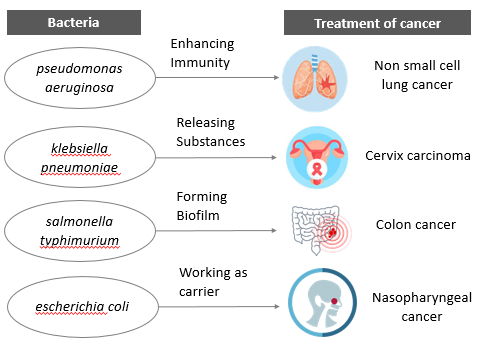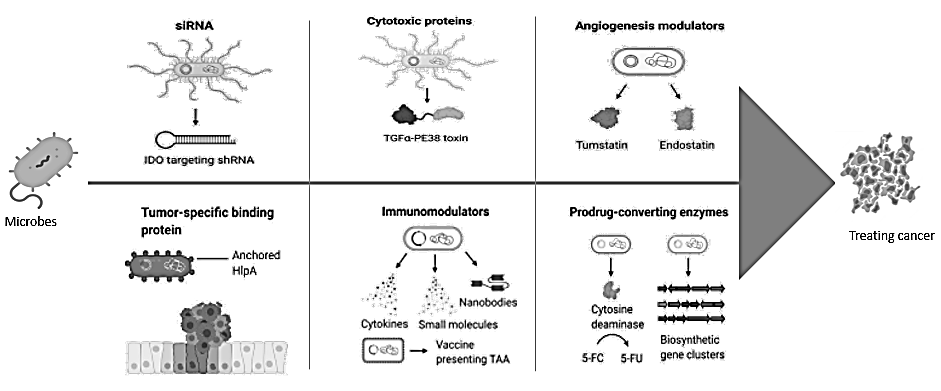Live bio-therapeutics indulging microbes have become the treatment of choice for cancer due to the toxic adversary caused by traditional treatment methods like- chemotherapy, radiation, and surgery. The modified/unmodified microbes have become valuable to the cancer treatment armamentarium. Scientists have identified live bacteria such as Bacillus spp., Clostridium spp., Escherichia coli, Listeria spp., and Salmonella spp. It is capable of treating cancer. These live bio-therapeutics can be genetically manipulated to be non-pathogenic, controllable, and produce or deliver various anticancer agents, making them ideal candidates for tumor treatment. These bacteria can be used singularly or combined with the traditional treatment methods, reducing toxicity. So, fighting cancer with bacteria is becoming a new norm.
Bacteria Therapy in Cancer
Bacteria may be helpful or harmful to humans based on how they are used or ingested into the human environment. The use of living bacteria in treating a disease is called Bacteria Therapy.

- Bacteria Monotherapy: Research studies have shown bacteria alone working as an anti-cancer agent by releasing anti-tumor toxins, activating and inducing anti-tumor effects, and forming a biofilm.
- Bacteria-Mediated Synergistic Therapy: Bacteria alone may not show complete potential in cancer treatment. The use of bacteria modified through genetic modification and/or in combination with other therapeutic methods, such as chemotherapy, photo-thermal therapy, immunotherapy, reactive oxygen species (ROS) or reactive nitrogen species (RNS) therapy, and prodrug activating therapy, which will improve treatment effectiveness, drug targeting properties, and safety.
- Micro-Robots for Cancer-Killing: Scientists have developed a method to deliver enterotoxins to kill cancer through a magnetic field-steered bionic bacteria. These micro-bots are steered to the site of cancerous tissue for precise delivery of enterotoxins to shrink and kill these tumor cells rapidly.
- Spatio-Temporal Controlled Bacteria: Various methods, such as light, chemical, pH, ultrasound, magnet, electrostatic, etc., are used to control the movement of bacteria to locate tumor cells and destroy them.
How Can Bacteria Fight Cancer?
Microbes target tumors by different mechanisms. Below are some of the tumor-suppressing means of bacteria:

- Accumulating and spreading bacterial colonies in tumors
- Inducing apoptosis/autophagy
- Producing toxins for cancer cells through normal engineered bacteria, micro-bots, spatiotemporal stimulated microbes, etc. (E.g., colicins, phenazine, pediocin, microcin, nisin, and pyocin, etc.)
- Regulate the secretion of cytokine and activate the antitumor activity of CD8+ T cells
- Activate the inflammasome (NLRP3, IPAF)
- Induce the expression of proinflammatory cytokines (E.g., IL-1β, IL-18, and TNF-α)
- Reducing angiogenesis and neovascularization
- Microbes engineered for virulence attenuation, precise tumor targeting, and regulation of anti-cancer molecular mechanisms; production and/or delivery of the cytotoxic proteins, angiogenesis modulators, immunomodulators, prodrug-converting enzymes, small interference RNAs (siRNAs), anticancer antibodies and anticancer medicine.
Fighting Cancer With Microbes: Recent Technology Trends
Different enthusiastic individuals are working on expanding the use of living microbes in malignant treatment, especially by using Salmonella, Listeria, and E.coli along with molecular gene modulation techniques. Here are some of the recent cancer therapy developments using live bacteria:
- Engineered E.coli releases an anti-cancer protein when activated by ultrasound.
- Programmable Microbial encapsulation may help effectively deliver microbes for therapeutics. Bacterial surface capsular polysaccharide (CAP) genes are natural extracellular biopolymers that coat the extracellular membrane and protect microbes from various environmental conditions. This CAP encapsulation system temporarily hides therapeutic bacteria from the immune system, delivers drugs to tumors, and makes it possible to kill cancer cells in mice.
- Injection of genetically attenuated Flagella bacteria transport antigen activates dendritic cells and increases the antitumor effect.
- Gene-modified Listeria monocytogenes bacteria express the tetanus-toxin protein inside the tumor cells, which triggers CD4 T-cells to attack and kill the pancreatic tumor cells.
- A synthetic probiotic called Pediococcus pentosaceus delivers P8 therapeutic protein that can reduce colorectal cancer (CRC). The mechanism of action is through a genetically engineered Pediococcus pentosaceus comprising a gene cassette with a solid inducible promoter encoding therapeutic protein P8 fused to secretion peptide and a complementation system. When this probiotic bacteria is delivered, it effectively decreases CRC in mice by reducing microbes associated with dysbiosis.
- Colorectal cancer reduction by the reprogrammed E. coli strain enabled efficient expression of HlyE in a temporal control manner and exhibited tumor-specific colonization.
- Recent clinical trial studies NCT04167137, NCT04049864, NCT04025307, and NCT03847519 have shown the treatment of various cancers such as Metastatic Solid Neoplasm, Lymphoma, Relapsed Neuroblastoma, Solid Tumours, Lung Cancer, Metastatic Squamous Cell Carcinoma and Metastatic Non-Squamous Cell Carcinoma was done by using bacteria.
Fighting Cancer With Bacteria Therapy: Future
Like any other cancer treatment, bacterial therapy faces challenges, risks, and limitations. Some of these include:
- Unpredicted pathogenicity of bacteria
- Risk of systemic infection
- Incomplete tumor lysis
- Lack of symmetrical growth of bacteria in the tumor
- Patient Safety and Regulatory Guidelines
- Mutation possibilities of genetically modified bacteria
Researchers use genetic tools for cancer treatment to overcome limitations and improve the quality of microorganisms.
One can achieve this by incorporating genetic engineering DNA sequences inside microbes and encapsulating the microbe with programmable sequences. This approach enables the precise and targeted delivery of therapeutic sequences. Recent technology trends show that tumor-targeted bacteria therapy will move forward in the future with
- Site-specific controlled treatment
- Precise delivery of antitumor medication
- Riskless cancer vaccination
Bacteria might be a strong ‘living medication’ and a significant cancer prevention and treatment tool. As genetic engineering techniques evolve and improve in sophistication, they actively contribute to solving safety and regulation issues.
Fighting Cancer With Bacteria: Market Trends & Major Competitors
Many biotech companies and academics are expanding their investment, research & development operations, and underway clinical trials. The following are some significant players’ activities in the tumor-targeting bacteria market.
- Prokarium, a biopharmaceutical company, collaborated with Lausanne University Hospital to license Salmonella immunotherapy to treat bladder cancer.
- 4D Pharma is the pioneer in harnessing bacteria as live bio-therapeutics. It uses drug-like functionalities and is enabling its MicroRx® platform for several diseases, including cancer.
- 4D Pharma and Merck entered a research collaboration to develop LBPs for vaccines by utilizing 4D’s proprietary MicroRx® platform.
Researchers conducted a joint clinical study to administer a combination therapy of MRx0518 (a live biotherapeutic product) and pembrolizumab (Keytruda) to patients with solid tumors, including non-small cell lung cancer, renal cell carcinoma, bladder cancer, or melanoma.
- Synlogic’s SYNB1891, composed of a synthetic biotic strain of E.coli Nissle, plays a vital role in initiating anti-tumor immune response via APC activation.
- Ernest Pharmaceuticals works around programmed bacteria to destroy cancer and utilizes a Salmonella-based intracellular delivery system. Ernest’s salmonella appears to have genetic circuits that enable autolysis and induce the release of anti-cancer proteins from the bacteria after invasion into a tumor.
- Actym Therapeutics Inc works around a therapeutic platform, wherein the platform is based on a gene-edited immunologically cloaked microbe capable of overcoming a tumor microenvironment that has become hostile to T-cells.
- City of Hope’s novel Clostridium butyricum MIYAIRI 588 strain (LBP CBM588) has showcased improved checkpoint inhibitors’ efficacy in treating cancer, including metastatic renal cell carcinoma.
- Genome & Company’s oral microbiome treatment candidate, GEN-001, is a pipeline product for immune-oncology treatment. It has a single strain of Lactococcus lactis isolated and identified from a healthy person.
Fighting Cancer With Bacteria: Conclusion
Cancer therapy is important for a patient undergoing the treatment. Understanding the interaction between commensal microbiota/ engineered Phage-based microbiome and the host of engineered live microbe-based therapeutics on host health is of utmost importance. However, it is still lacking and has risks, challenges, and limitations. They may trigger various kinds of responses in the human body, like immune responses. The promising results of bio-therapeutics, either by probiotic approach, micro-bots, or genetic alteration in microbes, are one-sided. The main challenge we must overcome is the detailed understanding of microbial-based therapy’s underlying molecular mechanism of action.